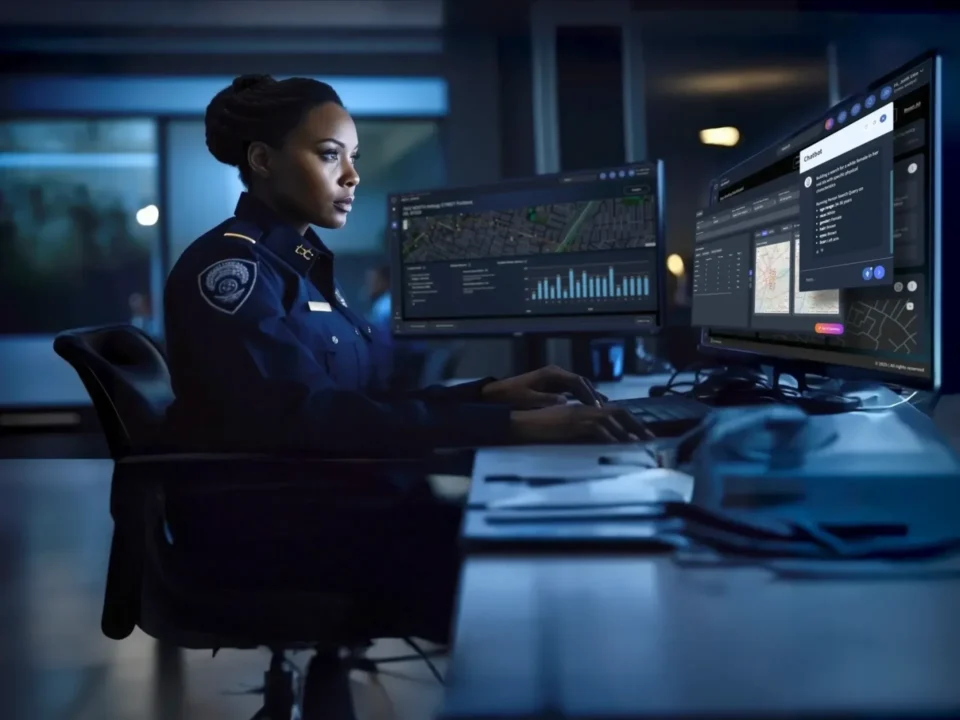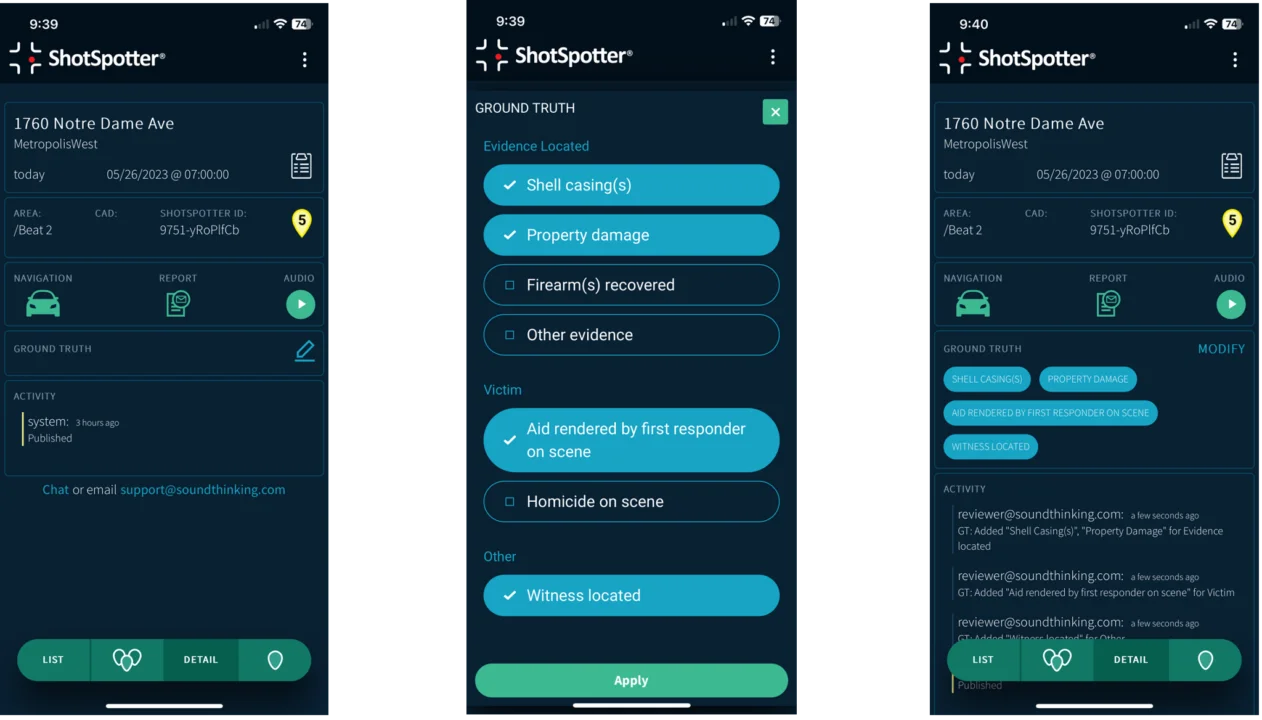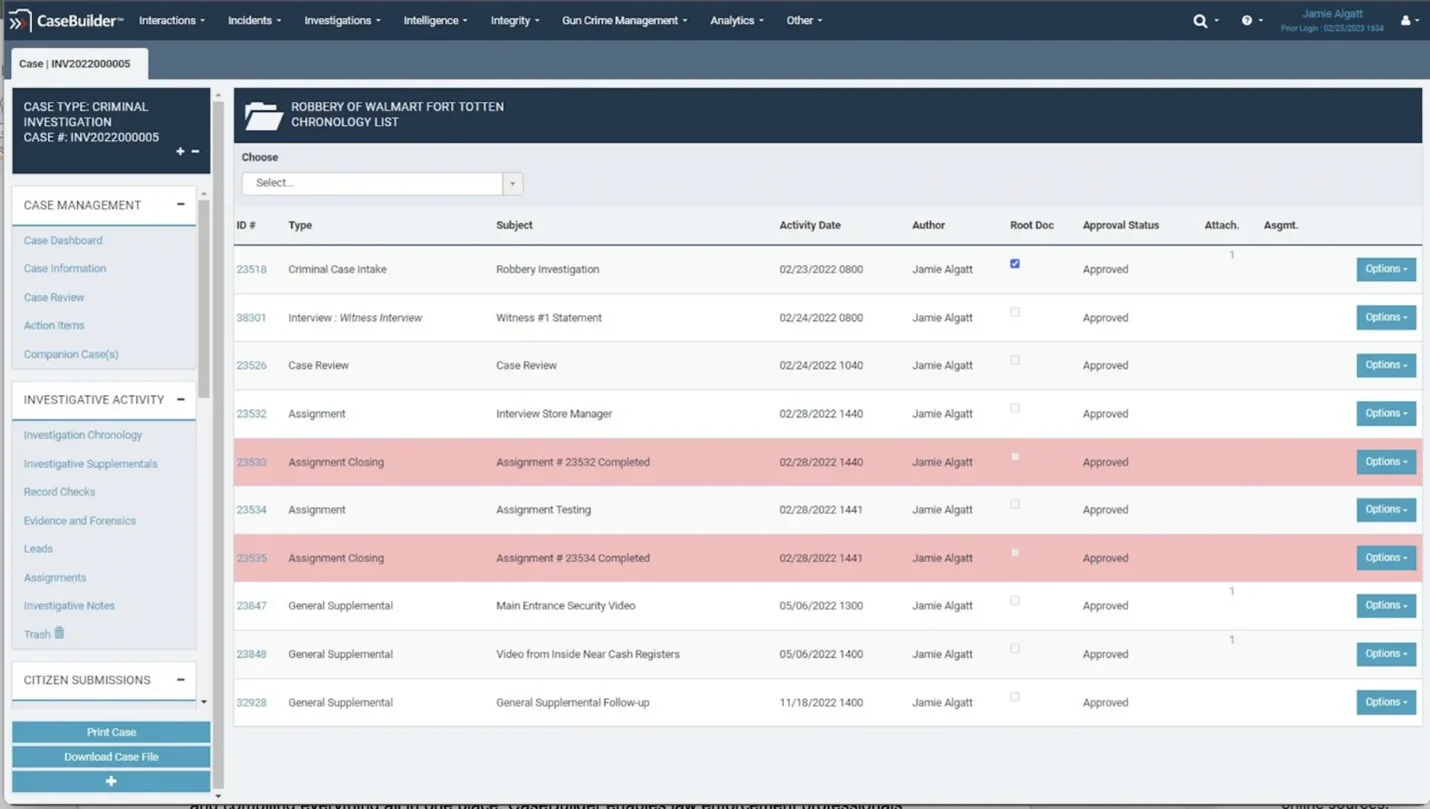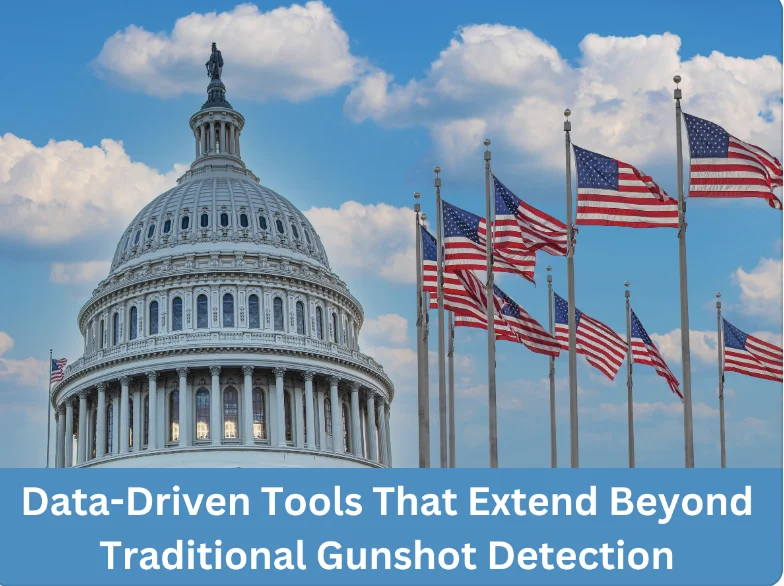In a previous article, we explored the importance of strategic policing and deploying officers where they’re needed most. Building on that foundation, this piece focuses on how public safety technology, specifically SoundThinking’s SafetySmart Platform, can serve as a force multiplier that enhances officer effectiveness, streamlines investigations, and strengthens community safety without overburdening personnel.
Gunshot Detection for Quicker Response and Accurate Locations
Gun violence in America’s cities is a devastating epidemic, yet research shows that up to 80% of gunfire goes unreported to police. Even when 9-1-1 calls are made, location details are often inaccurate, forcing officers to spend precious minutes chasing down the scene. Those delays mean less time to assist victims, preserve evidence, and collect witness statements, all critical steps that can determine whether a case is solved or goes cold.
ShotSpotter equips agencies to respond strategically, not reactively. By delivering near-instant, pinpoint-accurate gunfire alerts, officers can be dispatched with confidence, maximizing limited resources, prioritizing areas of highest need, and ensuring faster victim aid and evidence recovery.
Unlike other systems that overwhelm officers with false positives, ShotSpotter pairs advanced machine learning with human verification in its 24/7 Incident Review Center. This unique process ensures that every alert is actionable, enabling police to allocate manpower efficiently and reduce wasted response.
Beyond immediate response, ShotSpotter delivers the data agencies need for long-term strategy. Gunfire activity logs reveal patterns and hotspots, while Ground Truth reporting lets officers log details such as shell casings, victims, or property damage directly in the app. This intelligence enhances case management, informs precision policing initiatives, and enables leadership to make data-driven decisions about patrol deployment, violence reduction programs, and community engagement.
Officer’s view of Ground Truth from the ShotSpotter app
By combining real-time alerts with actionable analytics, ShotSpotter enables agencies to respond more effectively today while developing smarter, more strategic policing strategies for the future.
AI-Based Vehicle and License Plate Recognition for Enhanced Investigations
Just as with gunfire, many crimes involving vehicles aren’t reported quickly or accurately enough for officers to intercept a suspect vehicle. And with limited staffing and field visibility, most agencies can only manually scan a small number of plates during routine patrols. That gap in awareness means critical leads, such as a suspect vehicle near a crime scene, can easily be missed, slowing investigations and reducing clearance rates.
PlateRanger is built to address these challenges through a strategic, intelligence-driven approach to policing. Powered by AI and proven camera technology, the platform delivers precise license plate reads along with advanced vehicle recognition, including make, body type, and state. Results are displayed in a CJIS-secured, cloud-based interface, giving officers and analysts a reliable foundation for decision-making and deployment.
PlateRanger doesn’t just provide data — it integrates seamlessly into the broader policing ecosystem. Real-time connections with BOLOs, NCIC hits, and Amber or Silver alerts ensure agencies can prioritize the highest-risk vehicles and incidents. Its integration with ShotSpotter helps identify vehicles tied to gun violence, while CrimeTracer expands investigations across a nationwide network of vehicle reads. Together, these integrations give departments greater situational awareness and investigative reach, even with limited resources.

PlateRanger dashboard
By combining actionable vehicle intelligence with system-wide interoperability, PlateRanger enables agencies to deploy resources strategically, accelerate investigations, and strengthen their ability to prevent and solve crimes. The result is not just more efficient policing, but smarter, more proactive public safety.
Data-Driven Patrol Management to Ease Staffing Shortages
The International Association of Chiefs of Police’s (IACP) 2024 workforce survey found that more than 70 percent of agencies report recruiting is harder today than it was five years ago, with departments operating at just 91 percent of their authorized staffing. A Police Executive Research Forum (PERF) study released in April 2024 echoed the challenge, showing sworn staffing still 4.9 percent below pre-pandemic levels — with the largest agencies hit hardest. Even where hiring has improved, vacancies remain a pressing issue, leaving patrol stretched thin and driving operational strain.
In this environment, strategic policing requires more than just filling shifts; it demands smarter deployment of the officers already in the field. ResourceRouter provides agencies with exactly that capability, turning data into strategy. By ingesting crime reports, ShotSpotter® gunfire alerts (where available), and risk-terrain factors, the platform automatically generates directed-patrol areas — clear, shift-specific “boxes on the map” — designed to guide officers to where their presence will have the greatest impact.
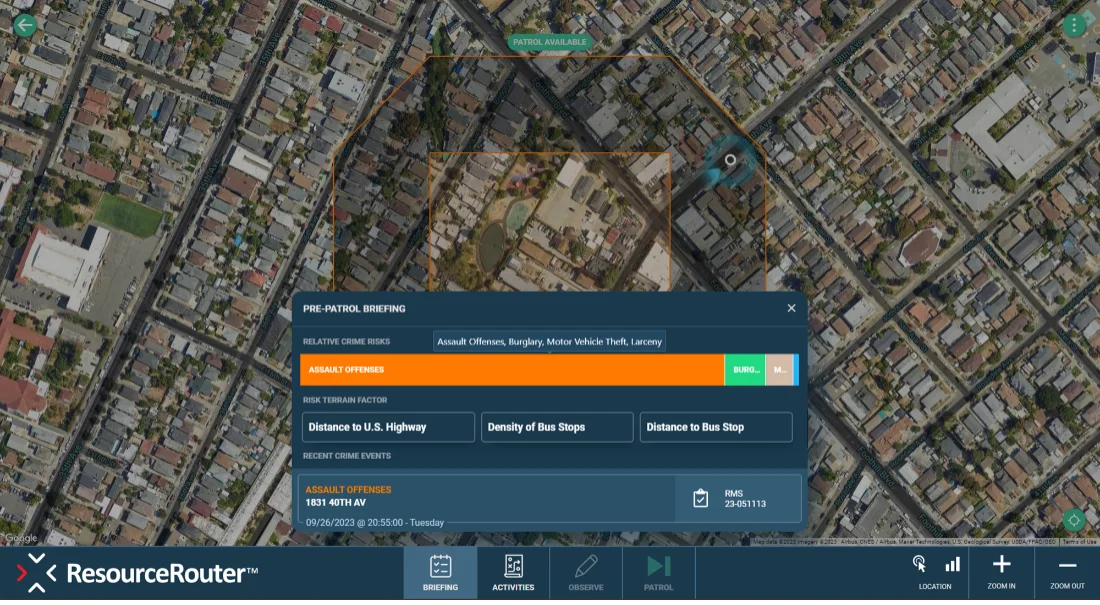
An example of a pre-patrol briefing for an assault offenses crime type.
ResourceRouter reinforces this intelligence with activity recommendations that align with the Koper Curve Principle, encouraging 10–15 minutes of focused presence in the right locations to deter crime for hours. This approach enables agencies to maximize the effectiveness of limited patrol resources, reduce officer burnout by creating a more sustainable workload, and ensure that deployment decisions are tied to measurable outcomes.
By combining evidence-based strategies with operational efficiency, ResourceRouter empowers law enforcement to do more than keep up with demand; it helps them proactively shape safer, stronger communities, even amid staffing challenges.
Leveraging Case Management and Law Enforcement Data Management Systems to Expedite Investigations
It is widely recognized that the first 48 hours following a gun crime or any serious offense are decisive in determining whether a case is solved or goes cold. For agencies facing staffing shortages, this window underscores the need for strategies and tools that amplify limited resources, strengthen investigative capacity, and sustain momentum well beyond the initial response. The answer lies in adopting force-multiplying technology that turns data into actionable intelligence.
Traditionally, officers have been slowed by paper-based processes, fragmented systems, and underpowered RMS modules that silo information instead of accelerating investigations. CaseBuilder changes that dynamic by allowing patrol officers to capture field notes, videos, and witness statements directly in one system. Seamless integration with CrimeTracer ensures investigative leads flow automatically into the case folder, reducing delays and keeping cases moving forward.
Import CrimeTracer leads into CaseBuilder with one click
Strategic policing also requires broad, immediate access to information. CrimeTracer delivers that capability with a powerful law enforcement search platform offering over one billion records. Its intuitive Chatbot removes barriers to complex queries, letting officers ask plain-language questions and instantly surface leads, suspects, and connections that might otherwise take days to uncover. This intelligence-driven approach balances three core priorities: reducing crime, engaging communities, and keeping officers safe.
CrimeTracer AI chatbot demo
Together, CaseBuilder and CrimeTracer act as true force multipliers — accelerating investigations, streamlining workflows, and freeing officers to focus on higher-impact work. In an era of constrained resources, this efficiency isn’t just helpful; it is essential to maintaining public trust and achieving durable crime-reduction outcomes.
That said, technology alone cannot deliver change. Success in strategic policing requires human buy-in from leadership aligning technology to agency priorities, to officers adopting tools in the field, to communities understanding their role in safer neighborhoods. When agencies pair modern technology with intentional leadership and stakeholder engagement, they position themselves not just to respond more effectively, but to build lasting public safety strategies for the future.
Establishing Buy-in with Internal Stakeholders
Sergeants play a pivotal role as the conduit between leadership and frontline officers. For any vision of strategic policing to take hold, agencies must secure the buy-in of their sergeants. Their insights into morale, policy, and culture not only shape day-to-day operations but also determine whether new initiatives succeed or stall. In this sense, sergeants are not just supervisors — they are on-the-ground agents of change who translate strategy into practice.
Aligning with stakeholders at every level begins with visibility and engagement. Attending roll calls and meeting officers where they are demonstrates that leadership values their perspective and understands the realities of their workload. Officers need to see firsthand how new tools and approaches can reduce administrative burden, improve safety, and enhance outcomes. Equally important is showing the breadth of use cases and long-term benefits, making it clear that these solutions are designed to support both the individual officer and the broader mission.
When leadership, sergeants, and frontline officers are aligned — and when technology is framed not as another task but as a resource to make policing smarter and more sustainable — agencies create the conditions for true strategic policing. This alignment transforms tools into trusted assets and policies into practices that deliver lasting public safety impact.
Establishing Buy-in with External Stakeholders
Strategic policing depends on alignment across all stakeholders, and that begins with political support. Engaging early and often with the mayor ensures that departmental strategies are in sync with the city’s broader public safety vision. Regular presence at city council meetings allows agencies to hear directly from elected officials, strengthen relationships, and build trust. These conversations are opportunities to demonstrate how investments in technology contribute not only to safer streets but also to long-term efficiency, accountability, and community well-being.
Equally important is transparency with the public. Strategic policing requires more than deploying tools — it requires community confidence in how those tools are used. By showing up consistently at neighborhood meetings, community forums, and local events, agency leaders can answer questions, listen to concerns, and create channels for ongoing dialogue. This visibility builds trust, reinforces legitimacy, and ensures that public safety strategies are both responsive and sustainable.
A Path Forward
Strategic policing today requires more than traditional approaches — it calls for innovation that directly addresses modern public safety challenges. By treating technology as a true partner in policing, agencies can deploy resources more strategically, enhance the speed and precision of response, and build stronger trust with the communities they serve.
